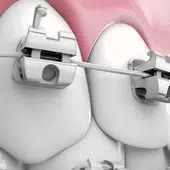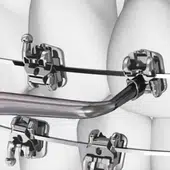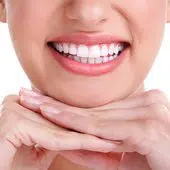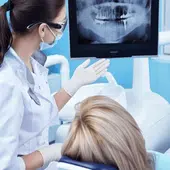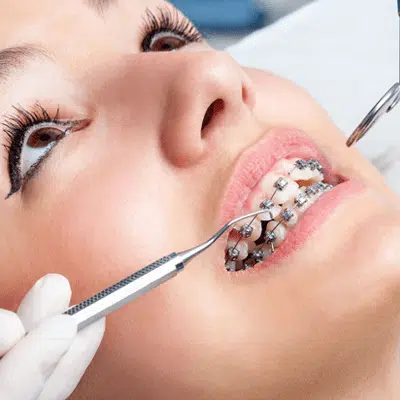Self-Ligating Bracket
Self-ligating brackets are quickly changing the face of braces. These easy-to-use brackets make adjustments quicker meaning less chair time for patients. The streamlined design creates a lower profile appearance, making them less “in your face” than traditional metal braces.
Self-Ligating Brackets vs. Traditional Brackets
Self-ligating brackets and traditional metal braces use the same principle to create tooth movement. Using tension created by the archwire, the force to shift teeth is generated and pulls teeth into alignment. The difference is in how the archwire is secured to the bracket. The wire is held with tiny rubber bands or wires called elastics or ligatures with traditional brackets. While elastics can be colorful and fun in expressing school spirit or your favorite sports teams, they are also prone to breakage.
Self-ligating brackets utilize a small locking clip on the bracket to hold the archwire in place. The benefits of self-ligating brackets include:
- A lower level of patient discomfort
- Faster results
- Fewer office visits
- Easier maintenance
- Easier cleaning
While very similar, most patients (and doctors) prefer self-ligating brackets. The primary complaint with self-ligating braces is that patients often state that they experience the most pain right after installing the archwire. Most state that they experience only minimal discomfort is felt following adjustment. With traditional braces, discomfort is mentioned after each adjustment.
Two Types of Self-Ligating Brackets
There are two different types of self-ligating brackets available.
- Active brackets employ a sliding mechanism with a spring clip. This mechanism applies pressure against the archwire, creating an active force.
- Passive brackets use a sliding mechanism that does not apply pressure against the archwire.
Both types of self-ligating brackets still require periodic adjustment by the orthodontist. Each time the doctor adjusts, they change the force applied to the teeth. These changes are what guide the teeth to shift into the proper positions.
Do Braces Hurt?
Not really. The brackets are bonded to your teeth. You may experience minor discomfort when you first get braces as your mouth adjusts to the new hardware. You can expect some minor tenderness from the brackets rubbing against the inside of your mouth. Usually, applying dental wax over the brackets, causing the tenderness helps. You can use over-the-counter medications to ease discomfort as necessary. It is essential that you contact Spain Orthodontics if you experience more severe pain.
Caring for Your Braces
Whether you have traditional metal braces or self-ligating braces, maintaining a good oral health routine is vital. Brush your teeth at least twice daily but optimally after each meal. Follow the recommended food choice list avoiding hard, chewy, and sticky foods that may damage your braces. Floss at least once daily, and be sure to get to the gum line.
The primary reason to take good care of your braces is to avoid extending your treatment period. You can eat plenty of foods safely without worrying about damaging your braces. Our staff has compiled a list of braces-safe foods and snacks for you. If you have questions about caring for your new braces, please don’t hesitate to contact the office.
The Most Complete Self-Ligating Bracket System in the World
Self-ligating braces are an excellent choice to help achieve your perfect smile and can help make wearing braces a more positive experience.
To recap — self-ligating technology has a clip that holds the archwire instead of traditional rubber bands (ligatures). Elastics can stain and wear out over time. These clips mean less pressure and friction on your teeth and allow your orthodontist to make quicker, easier wire adjustments, which can translate to less time in the orthodontic chair.
Self-ligating brackets are all about your comfort. They have contoured edges and sculpted, low-profile designs to provide a smoother surface against your cheeks and lips.
learn moreClear Braces — Self-Ligating Clear Braces
Having braces doesn’t have to be a depressing moment in life. With clear ceramic self-ligating braces, most people won’t even know you have braces. The brackets are smaller and transparent, so they blend with the color of your teeth.
Beauty and Performance Come Together with Clear Ceramic Braces
Clear braces are technologically advanced. The ceramic bracket system works the same as traditional metal braces. It straightens your teeth using the science we have relied on for hundreds of years. Hundreds of years? Braces have been used from 400 to 300 BC, although they are much improved with modern procedures and materials. With clear self-ligating braces, you will be confident to smile during and after treatment. Your journey to a beautiful smile can begin today.
Clear braces use the principle of tension to shift teeth into alignment. To make this work, the doctor affixes brackets to your teeth and then connects the archwire to each bracket. As the doctor tightens the archwire, the tension creates the force that pulls your teeth into proper alignment. During each adjustment appointment, the doctor can shift the amount of tension to specific teeth, guiding the movement toward your final perfect smile.
Aesthetically-Pleasing and Efficient
Clear ceramic self-ligating brackets have a slim profile making them more comfortable, less visible, and more aesthetically pleasing. When used with a white archwire, clear braces blend with your natural smile and reduce visibility. Self-ligating braces are available in two types:
- Active brackets use a spring clip with a sliding mechanism. The clip applies pressure, securing the archwire and creating active force to assist in moving teeth.
- Passive brackets use a sliding mechanism but do not apply pressure to the wire.
Clear braces still require adjustments by the orthodontist throughout your treatment period. Still, they do have several advantages over their traditional metal counterparts:
- Less discomfort
- Quicker results in many cases
- Fewer adjustment office visits
- Easier oral hygiene and maintenance
The archwire is secured with small rubber bands (elastics) or wires with traditional braces.
Does Having Braces Hurt?
You will experience minor discomfort with clear braces. With self-litigating braces, patients have reported that the first day is the worst, but after that, discomfort is almost non-existent. You will have some discomfort following adjustments, but over-the-counter pain relievers should be sufficient in alleviating the feeling.
One of the primary causes of discomfort is adjusting to the hardware rubbing inside your mouth. Dental wax can be applied to the brackets causing discomfort to ease the friction. If you feel more than slight discomfort, you should contact Spain Orthodontics and discuss it with a staff member. They can offer pointers and schedule you for an appointment if there is a problem.
Caring for Your Self-Ligating Clear Braces
Having braces means taking special care of your teeth. Although you will have the same general routine (brushing two or more times daily and flossing daily), the process may take a few minutes longer. Although you should avoid some foods while you have braces, there are plenty of braces-friendly foods and snacks for you to enjoy. Once you learn the tricks to flossing, your routine will fit into your regular schedule.
Clear Braces Can Transform Your Smile
Clear braces are an effective and efficient alternative to traditional metal braces. The self-ligating brackets make them an excellent tool for Dr. Spain to perfect your smile.
If you are interested in a lower-profile way to straighten your teeth, talk to Dr. Spain about Invisalign® and Invisalign Teen®. This nearly invisible system of clear tray aligners is a great fit for busy lifestyles at school or work. They are cost-effective and easy to use. Invisalign is a patient-centered treatment requiring dedication to transforming your smile.
learn morePhase 1 (Early Treatment) and Phase 2
There are orthodontic advantages to treating certain cases in two separate stages.
The question we get most often is “What is the right age for my child to visit the orthodontist?”
Even if your child still has baby teeth, they should be seen by the orthodontist by age 7. Dr. Spain will not necessarily recommend treatment at that age, but enough permanent teeth have arrived for him to evaluate how the teeth and jaws meet, and to identify current or developing problems. If a problem is detected, Dr. Spain will discuss when treatment may be necessary. Sometimes Dr. Spain recommends treatment in younger patients when appropriate or may defer treatment until the patient is older if the problem is minor.
Typically, an Early Treatment (Phase 1) will be short and address a specific problem. Then, once treatment is completed, your child will be monitored by Dr. Spain until they are ready for comprehensive treatment (Phase 2). Often times, patients that require a phase 1 treatment will need a comprehensive treatment (phase 2) at an older age.
learn more



